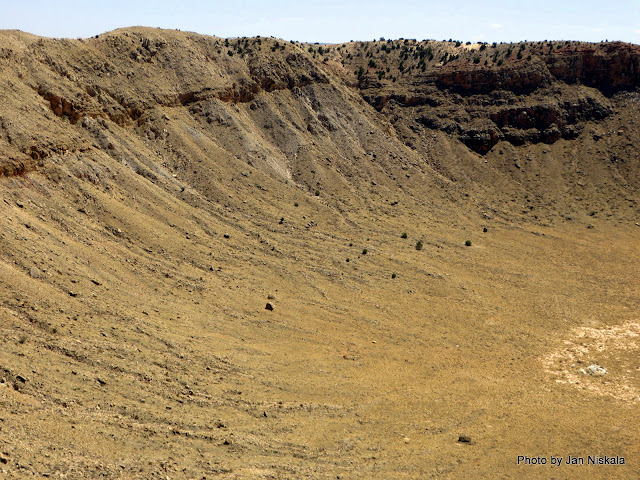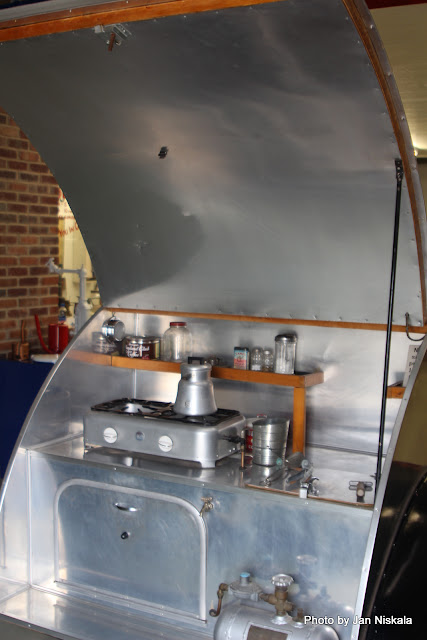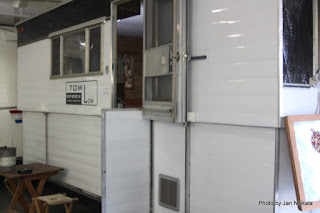The
Jack Sisemore RV Museum
There
is an RV Museum in Amarillo, Texas which we visited. They house RV’s beginning in 1921. The name of the museum is “The Jack Sisemore
Traveland RV Museum”. The Sisemore
family began collecting and restoring unusual and vintage RV’s about 25 years
ago. Some of these include the Flexible
Bus from the movie RV, the first Itasca motor home ever built and the oldest
Fleetwood in existence today plus many others from the 30’s, 40’s, 50’s, 60’s,
and 70’s. It is quite a nice step back
in time!
1921
Ford Lamsteed Kampkar Body came complete with full equipment and ready to mount
on the back of a Model “T” Ford pickup chassis.
The cost in 1921 was only $535.00 and only 5 were made by Anheser-Bush
of St. Louis, Missouri.
The
1936 “Alma” was found in a barn 20 miles from the Alma factory. It has never been restored and what you see
in the photos is all original. An exceptional
pre -war find!

1937
Kozy Kamp tent trailer was one of the first tent trailers ever built. The Kozy Kamp Company began building these in
1936 in Oregon. They were all dark green. This model had only one owner and was stored
in a garage when not in use. They
painted it blue black in the late 1950’s to match their family Cadillac.
 Items of the time that were placed around the Kozy Kamper!
Items of the time that were placed around the Kozy Kamper!
1946
Tear Drop Kit was restored by the museums restoration team 24 years ago and it
still looks like a new modern unit.
These units were built out of aluminum that was surplus after the war,
and many of the wheels had to have bullet doles repaired to be used. You can barely see the tear drop shape of
this little RV with the back hood raised showing the kitchen. The kitchens are still housed under the back
hood in today’s tear drop RV’s.
1948
Flxible is the Bus used by the Gornike family in the Robin Williams movie “RV”. The Bus in this museum is the Bus that modified
for the movie.

1953
Fleetwood trailer was in total disrepair when found at a filling station15
years ago and the Museum purchased it from an 84 years old lady that was
traveling across the country. She said
it was time for her to quit camping!!!
It took 2 years for the restoration team to complete bringing this
little RV back to life. This unit is the
first year Fleetwood built trailers and its serial number is 1123. Does anyone recognize the Coca Cola Cooler???

1962
Airstream called ‘little Bambi’ was acquired in 1988 but restored a couple of
years ago. She’s cute but really small!!
1966
Kenskill – Kenskill was a large manufacturer of travel trailers in the 60’s. Notice the lovely chrome work on the outside
of the unit and the unusual blue shower, sink and stove.

1970
Avion is a pick up camper and may be one of the last made by Avion Company. It
had only one owner and everything inside and out is original.

1973
Tow Low was an RV with unusual lift system.
It is hard to see but the system operates with the large front
wheel. This was a gift to the Museum,
restored by the staff and is the only RV like this that they have ever seen.
1974
Winnebago was actually a rental by the Sisemore family. It took two 1974 Winnebago’s to rebuild this
one. The owners or the Museum are also the oldest Winnebago dealer in the state
of Texas; they began selling Winnebago products in 1978.
1975
Itasca is the first Itasca Motorhome ever built with a serial number of #1. It has 6000 original miles on it and it is in
brand new condition.

1976
Argosy was made by the Airstream Company. It has been repainted changing the
stripes the red, white and blue in honor of the returning veterans from Iraq
and to commemorate the 1976 Bicentennial of our wonderful country. It is called the ‘Spirit of 76’.





1976
FMC Motorhome has an interesting lineage.
FMC is the acronym for Food Machinery Corporation, in 1883 inventor John
Bean developed and innovative insecticide pump, under the company name of John
Bean Manufacturing. The company’s
success in developing machinery and other mechanized products for the food
industry had caused the company name change to Food Machinery Corporation in
1928. The company eventually began
producing amphibious vehicles for the military.
During lulls between military contracts the company began building
recreational vehicles launching its motor coach division in 1972. The unit were
well made but pricey for the 70’s ranging between $27,000 and $54,500 which was
also the price range for and average home at that time. FMC’s were owned by Mario Andretti, Parnelli
Jones, Clint Eastwood, Carol Burnett, Pat Boone and James Brolin. But the most famous was CBS reporter Charles
Kuralt, host of the very popular news feature ‘On the Road with Charles Kuralt’. The energy crisis in the 1970’s put a damper
on all gasoline operated vehicles and only about 1000 units were manufactured.




The 1941 Westcraft Trailer, manufactured by a Los Angeles based company, was a top of the line trailer during the 1940's and 1950's. This particular trailer was owned by a defense worker during World War II. It was located in a special workers camp in the western US. The camp had a central washroom and bath since few, if any, trailers had built in bathrooms. The owner lived in the trailer until the end of the war. He later relocated to Palo Duro Canyon and parked the trailer. This trailer has a very rare Trolly Roof. Very few are known to exist.


This Harley was used during WWII, and is very rare as it has a left hand side seat.
There
were also many motorcycles in the museum all of them were beautifully restored.


This has been an overview of what is maintained in the museum. Again, it is in Amarillo Texas and it would be an interesting place to visit. Oh, and did I say it is free?
More to come soon!
Jan 🌷🌷🐾🐾



















































































